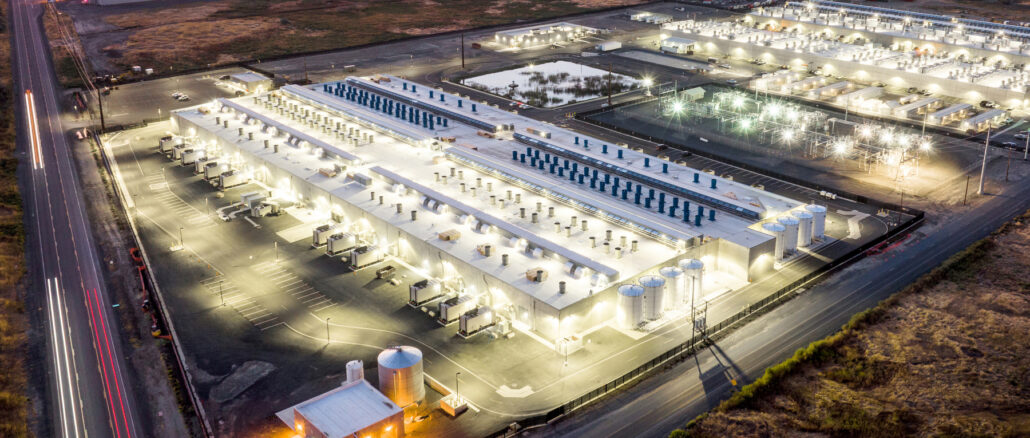 PDX Data Centers and Community
Amazon Web Services
Photo Copyright Noah Berger / 2022
PDX Data Centers and Community
Amazon Web Services
Photo Copyright Noah Berger / 2022
When you drive around the major metropolitan areas of this great country of ours, and indeed in any most of the developed countries at this point, you see two things.
One is giant warehouses the size of airplane hangars with zillions of loading bays evenly spaced along the outside. These are the massive distribution centers that encapsulate the transactions of the lion’s share of our economy.
The second thing that you increasingly see – and if you squint your eyes you can’t really tell that much of a difference at first – are what Google called a “warehouse-scale machine” way back in 2009 and what we still call a datacenter. These encapsulate the remaining part of our economy, and instead of moving goods between producers and consumers, they process transactions and feed us applications for our work and our amusement. The hyperscalers create a few applications that span tens of thousands of machines in each datacenter, while the clouds run millions of applications for millions of customers across thousands of datacenter regions around the world.
You can’t participate in the IT sector, or the modern economy, without having at least a little fascination for datacenters. These are big, expense, complex systems that are foundational and integral to what we do, and they are where the current platforms live and where the next platforms will reside.
When we moved to western North Carolina nearly a decade ago, we knew this part of the United States was rich in space, electricity, and water – the three things that datacenters love most. These are also things that the textile and furniture manufacturing businesses that used to comprise a lot of the industry in this area loved, and so it is not a coincidence that the infrastructure for datacenters is already available in many places.
What we didn’t know until after we bought our house was that we had a line of sight view down mountain of Google’s datacenter in Lenoir, which was built way back in 2007 and expanded a bit since then for $1.2 billion and which could see a $600 million expansion soon if the rumors are correct. It is an ever-present part of our life, and particularly stunning during golden hour or on winter mornings when the steam rises out of it like Indian pipe fungus, also known as ghost pipes, which like to hang our with beech trees.
Apple followed suit in 2009 with a $1 billion investment to build its first datacenter a little to the south in Maiden, which we can almost make out on a clear day a bit further down the curvature of the Earth and a little to the left.
If we could look to the left a little more and squint a bit more – or perhaps get a better set of binoculars – we might just be able to make out the Meta Platforms datacenter in Forest City, west of Charlotte. This innovative facility was the second datacenter built by what was then called Facebook, and it opened up in 2012. This is one of the datacenter regions we have actually toured, and it was created from the get-go to have three datacenters, which comprise 1.3 million square feet and have cost around $750 million in cumulative investment.
Back in 2022, Microsoft said that it would be investing $1 billion in four datacenters located in the same area, with one in Hickory (just south of Lenoir), two in Conover (just south of Hickory just north of Maiden), and one in Maiden, all along the Route 321 corridor preferred by manufacturers and datacenter operators out this way. The ground has been grated for these datacenters and Duke Energy has been working on the power distribution pads for them, but back in April the company, which plans to spend $80 billion on datacenter investments this year, backed off on its western NC investments for now. The projects have not been outright canceled – you don’t get permits for all of this and then back out – but they are on pause.
Which leaves more power to Amazon Web Services – both figuratively and literally. AWS has just announced a $10 billion datacenter investment in North Carolina, east of Charlotte and south of Greensboro. This is a massive investment by any standard, and is about to reshape the city of Rockingham the surrounding area of Richmond County. At least no one is lying about the number of permanent jobs it will create, which is estimated to be around 500. There will likely be many thousands of construction jobs as the facilities in Energy Way Industrial Park are built out over the years.
AWS has taken control of an 800 acre plot in the Energy Way Industrial Park, which is in close proximity to Duke Energy’s Smith Energy Complex, a series of gas-fired turbines that generate 2.2 gigawatts of juice. That energy plant opened at the tail end of the Dot Com Boom in 2001. The AWS portion of the park has capacity for 20 different buildings, ranging in size from 200,000 to 225,000 square feet, which puts the capacity at around 8.5 million square feet.
To give you some perspective, the datacenter capacity of Loudoun and Prince William counties in northeast Virginia, which is the densest datacenter spot on Earth, has about 130 million square feet of datacenter floor space spread around approximately 15 square miles, as we estimated when talking a few weeks ago about the massive AI datacenter investments going into Abu Dhabi. The Abu Dhabi facilities are about 0.67 Ashburns, and the AWS facility in Richmond County will be 1/15th of an Ashburn (about 0.065 or 6.5 percent) when fully built out.
This is the first big datacenter project for AWS in North Carolina, but Amazon has invested over $12 billion in the state for its retail distribution centers, which employ 24,000 part-time and full-time workers. The data warehouses require very few people, and for now the product warehouses still have a lot of people, although the robots are on the rise – thanks in no small part to AI, of course.
The It is hard to say how much AI computing will be spread across those 800 acres in the Richmond County facilities. If you look at the four-year cost of building and operating a datacenter and filling it with AI gear, about half of the cost comes from the facilities (including power and cooling) and half from the compute and networking. So you are really talking about $5 billion in gear. (This is a very rough estimate based on estimates made by Nvidia last year, which we riffed on here.)
At current prices for Blackwell B200 nodes with eight GPUs each or for fatter GB200 NVL72 rackscale systems, that works out to a total of 106,800 GPUs. If you think a Trainium2 costs around half as much as a Blackwell B200 GPU from Nvidia, then it is more like 220,000 Trainiums. If you think a Tranium2 is one third the price of a Blackwell B200, then you can buy 330,000 Traniums for the same money.
If you are looking at the Blackwell B200 as the accelerator deployed, this will be 4.5 petaflops at FP8 for dense matrices for each B200 GPU. That adds up to 480.6 exaflops at FP8 precision, and twice that with sparse matrices. At FP4 resolution, the B200 double pumps the performance. At the FP8 precision, somewhere on the order of 330,000 Trainium2 chips would yield 428.7 exaflops on dense matrices. The cost per flops is essentially the same, although the space required will be much higher for the Tranium2 setup. The Blackwell supports FP4 processing, which doubles its throughput. Hopefully for AWS, the Trainium3 will also have FP4 support to balance this out.
The fact that the cost per flops is in the same ballpark for Blackwell and Tranium is why we think there will be a lot of Tranium2 and then Trainium3 chips humming along in North Carolina on behalf of Anthropic, the creator of the Claude models and the company that AWS has pumped $8 billion into so far as its premiere model maker.
Sign up to our Newsletter
Featuring highlights, analysis, and stories from the week directly from us to your inbox with nothing in between.
Subscribe now
.png)





